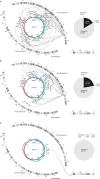Identification of human papillomavirus (HPV) 16 DNA integration and the ensuing patterns of methylation in HPV-associated head and neck squamous cell carcinoma cell lines
- PMID: 28006857
- PMCID: PMC5877459
- DOI: 10.1002/ijc.30589
Identification of human papillomavirus (HPV) 16 DNA integration and the ensuing patterns of methylation in HPV-associated head and neck squamous cell carcinoma cell lines
Abstract
Recent studies showed that human papillomavirus (HPV) integration contributes to the genomic instability seen in HPV-associated head and neck squamous cell carcinoma (HPV-HNSCC). However, the epigenetic alterations induced after HPV integration remains unclear. To identify the molecular details of HPV16 DNA integration and the ensuing patterns of methylation in HNSCC, we performed next-generation sequencing using a target-enrichment method for the effective identification of HPV16 integration breakpoints as well as the characterization of genomic sequences adjacent to HPV16 integration breakpoints with three HPV16-related HNSCC cell lines. The DNA methylation levels of the integrated HPV16 genome and that of the adjacent human genome were also analyzed by bisulfite pyrosequencing. We found various integration loci, including novel integration sites. Integration loci were located predominantly in the intergenic region, with a significant enrichment of the microhomologous sequences between the human and HPV16 genomes at the integration breakpoints. Furthermore, various levels of methylation within both the human genome and the integrated HPV genome at the integration breakpoints in each integrant were observed. Allele-specific methylation analysis suggested that the HPV16 integrants remained hypomethylated when the flanking host genome was hypomethylated. After integration into highly methylated human genome regions, however, the HPV16 DNA became methylated. In conclusion, we found novel integration sites and methylation patterns in HPV-HNSCC using our unique method. These findings may provide insights into understanding of viral integration mechanism and virus-associated carcinogenesis of HPV-HNSCC.
Keywords: DNA integration; epigenome; head and neck squamous cell carcinoma (HNSCC); human papillomavirus (HPV).
© 2016 UICC.
Conflict of interest statement
Disclosure of Potential Conflicts of Interest
The authors have no competing interests to disclose.
Figures





Similar articles
-
Viral load, gene expression and mapping of viral integration sites in HPV16-associated HNSCC cell lines.Int J Cancer. 2015 Mar 1;136(5):E207-18. doi: 10.1002/ijc.29112. Epub 2014 Aug 14. Int J Cancer. 2015. PMID: 25082736 Free PMC article.
-
Characterization of the methylation patterns in human papillomavirus type 16 viral DNA in head and neck cancers.Cancer Prev Res (Phila). 2011 Feb;4(2):207-17. doi: 10.1158/1940-6207.CAPR-10-0147. Cancer Prev Res (Phila). 2011. PMID: 21292634 Free PMC article.
-
Integrated virus-host methylome analysis in head and neck squamous cell carcinoma.Epigenetics. 2013 Sep;8(9):953-61. doi: 10.4161/epi.25614. Epub 2013 Jul 18. Epigenetics. 2013. PMID: 23867721 Free PMC article.
-
HPV Integration in Head and Neck Squamous Cell Carcinomas: Cause and Consequence.Recent Results Cancer Res. 2017;206:57-72. doi: 10.1007/978-3-319-43580-0_4. Recent Results Cancer Res. 2017. PMID: 27699529 Review.
-
The molecular mechanism of human papillomavirus-induced carcinogenesis in head and neck squamous cell carcinoma.Int J Clin Oncol. 2016 Oct;21(5):819-826. doi: 10.1007/s10147-016-1005-x. Epub 2016 Jun 23. Int J Clin Oncol. 2016. PMID: 27339270 Review.
Cited by
-
Methyltransferase G9a promotes cervical cancer angiogenesis and decreases patient survival.Oncotarget. 2017 Jul 7;8(37):62081-62098. doi: 10.18632/oncotarget.19060. eCollection 2017 Sep 22. Oncotarget. 2017. PMID: 28977928 Free PMC article.
-
Detailed Characteristics of Tonsillar Tumors with Extrachromosomal or Integrated Form of Human Papillomavirus.Viruses. 2019 Dec 30;12(1):42. doi: 10.3390/v12010042. Viruses. 2019. PMID: 31905862 Free PMC article.
-
Genome integration of human DNA oncoviruses.J Virol. 2025 Aug 19;99(8):e0056225. doi: 10.1128/jvi.00562-25. Epub 2025 Jul 23. J Virol. 2025. PMID: 40699151 Free PMC article. Review.
-
Causes and Consequences of HPV Integration in Head and Neck Squamous Cell Carcinomas: State of the Art.Cancers (Basel). 2021 Aug 13;13(16):4089. doi: 10.3390/cancers13164089. Cancers (Basel). 2021. PMID: 34439243 Free PMC article. Review.
-
Association of viral load and physical status of HPV-16 with survival of patients with head and neck cancer.Ecancermedicalscience. 2020 Jul 30;14:1082. doi: 10.3332/ecancer.2020.1082. eCollection 2020. Ecancermedicalscience. 2020. PMID: 32863876 Free PMC article.
References
-
- Ferlay J, Shin HR, Bray F, Forman D, Mathers C, Parkin DM. Estimates of worldwide burden of cancer in 2008: GLOBOCAN 2008. Int J Cancer. 2010;127:2893–917. - PubMed
-
- Gillison ML, Koch WM, Capone RB, Spafford M, Westra WH, Wu L, Zahurak ML, Daniel RW, Viglione M, Symer DE, Shah KV, Sidransky D. Evidence for a causal association between human papillomavirus and a subset of head and neck cancers. J Natl Cancer Inst. 2000;92:709–20. - PubMed
-
- Ndiaye C, Mena M, Alemany L, Arbyn M, Castellsague X, Laporte L, Bosch FX, de Sanjose S, Trottier H. HPV DNA, E6/E7 mRNA, and p16INK4a detection in head and neck cancers: a systematic review and meta-analysis. Lancet Oncol. 2014;15:1319–31. - PubMed
MeSH terms
Substances
Grants and funding
LinkOut - more resources
Full Text Sources
Other Literature Sources
Medical

